Menus
- The scooter missing between 250 and 530 cm3 in tune
- Discovery
- In the saddle
- Contact
- In the city
- Highway
- Comfort
- Braking
- Consumption
- Convenient
- Conclusion
- Test conditions
The scooter missing between 250 and 530 cm3 in tune
XMax 125, XMax 250, TMax 530…. one could have imagined that Yamaha would go hunting on the roads of the SRV 850 to complete its range, but it is rather the junction between 250 and 530 that has just been made with the XMax 400, to the detriment of the late Majesty 400, which it inherits in part from the engine. In fact, the XMax is powered by a new 4-valve two ACT 4-stroke liquid-cooled single-cylinder engine, an evolution of the one fitted to the Majesty with power increased to 31.5 horsepower at 7,500 rpm. So, the ideal solution for urban and peri-urban use, because it is smaller than a TMax but more powerful than a 250? Test….
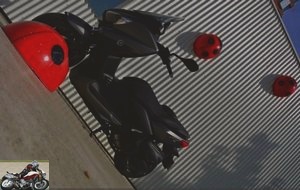
Discovery
The XMax lineage is so obvious that it’s hard to tell the difference in displacement from the model in front of you at first glance. We find the same slender, sporty, fine, dynamic overall line.

The double front optic is both characteristic of the XMax family and in line with Yamaha’s elegant optics. At the rear, there is a double light (still as on the 125 and 250), now in LED (1st maxi-scoot to benefit from it) but more sharp, marking in a superior way the announced sportiness of the model.
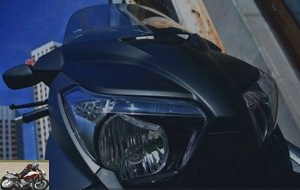
The tuning forks brand has once again been able to play on the alternation of matt, chrome and painted parts for a particularly successful result, both from a distance and up close. Because the quality of the details up close is simply impressive, from the part casings, to the logo detail on the saddle, or to the matt of the grab handles..
Then there is a relatively high bubble, with a central air intake, a matt black engine and exhaust, a two-stage saddle (separated by an aluminum part with the tuning fork). The side pockets themselves are well made, in terms of finish but also handling and open and close easily.
The whole offers a pretty line, rewarding and even more pleasant in its white livery, precisely by the alternation of white, gray and black.

In the saddle
The XMax have an important saddle height, reinforced even more and especially by the width of the saddle. Because indeed, if on paper, the saddle height is only 785 mm and therefore within the usual standards, in practice, it is high. So with a wide saddle, the 1.70m rider will just tip his toes to the ground. You actually have to do more than 1.80 to hope to be able to put both feet on the ground. Fortunately, the center of gravity is low and makes it possible not to feel the 211 full kilos made of the machine.
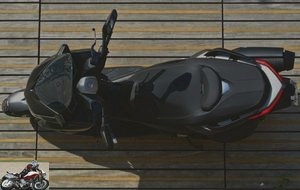
The dials of the round table of the smaller engines have here become hexagonal, more sporty. We then discover before our eyes a double analog counter (speed on the left, tachometer on the right) which frames a digital screen displaying: totalizer, partial double trip, clock, fuel gauge, exterior temperature and engine temperature, change of gear alert. oil). Everything is very readable, even under the sun.
That said, the eye tends to look mostly at the central screen in a natural way. So, looking at the speed we have so as not to exceed – easily – the authorized speeds requires a little attention.
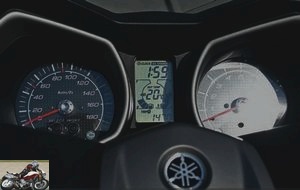
The position is natural and the handlebars instinctively fall under the hands. If the saddle is high, the floor is also high and the legs are noticeably raised.
The mirrors finally offer excellent vision.
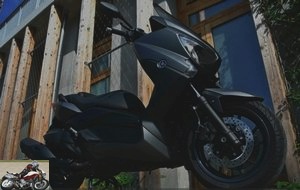
Contact
The counter is reset and the right handle gently causes the start of the 400. The tachometer needle climbs up to 6,000 rpm (red zone at 8,200 rpm) then goes down again between 4,500 and 5.00 rpm in speed function. There is 8 Nm more power than the 250 cm3 but also 31 kilos more on the scale. Suddenly, if we hoped to get closer to the TMax, we are closer to the efficiency of the 250 than the 530. The fact remains that red light starts are effective.
In the city
The XMax 400 is an X-Max with all the advantages of the model’s size, whatever the displacement. Suddenly, the hourglass figure allows you to sneak around and at any pace with ease and without thinking about it.
With a tachometer oscillating more between 4,000 and 5,000 revolutions in the city, the scoot sometimes gives the impression of being spared. Handles on the cleat at a red light do not strip, but make it possible to get out of the first place.
The braking is then largely at the height of the inclinations of the maxi-scooter, even more powerful than necessary. In day-to-day use, you will even be content with two fingers to operate the front or rear with good feeling and instant power. It brakes and it even brakes very hard.
In town, the only downside will come from the possible presence of a passenger who, located higher up, brings a significant play of the balance and a little more difficulty at very low speed.
Be careful though with the prominent exhaust on the right which can allow you to touch down during slaloms between cars. We tell ourselves that it goes without worry and in fact, in the end, we touch…. before apologizing to the motorist (lived experience).
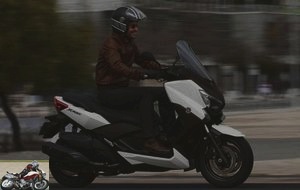
Highway
The XMax 400 takes off vigorously on the highway and quietly exceeds 130 km / h to stall at 140 km / h at 7,000 rpm at 1,200 rpm from the red zone. A red zone that he can approach well launched and slightly downhill to titillate 160 km / h (on the circuit), even if the last km / hours are obtained slowly. On the other hand, it can quite stall at 150 km / h over long distances without flinching or weakening. At this speed, the high bubble protects the upper body well and does not generate any particular sound or noise through the headphones more than usual. In fact, the screen is just at the right height because it never obstructs the pilot’s vision, even of small stature.
At this speed, the XMax even then greatly appreciates a passenger, which allows it to stabilize and make it take large curves at maximum speed without moving. On the other hand, in solo, the slightly light front and the high bubble tend to generate a slight shimmy in strong winds, an effect that disappears if you put a little more weight on the front solo or completely. effortlessly as a duo. But anyway, the highway code prohibits exceeding 130 km / h, so until then, everything is fine.
The simple low beams provide very good lighting and it is possible to drive hard and fast at night in full headlight with real lighting power.

Comfort
On long journeys, the saddle is rather comfortable. The passenger will confirm this comfort, helped by well-positioned handles. A journey of 450 km during the day as a duo for the test confirmed this comfort, with good use of the motorway.
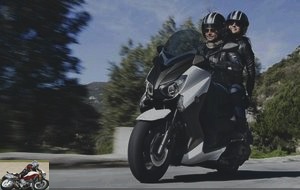
Now, if the XMax 125 and 250 were already firm, the XMax 400 is no exception to the rule, whether solo or duo. And there’s no point in changing the rear shock. This rigidity is linked to the very design of the two-wheeler, due to the location of the shock absorber which cannot play 100% of its role in the rear given its position. So, on smooth roads and motorways, solo and in duo, you can really ride for a long time without suffering thanks to an efficient saddle and well-designed grab handles for the passenger, in town, as soon as the road deteriorates even noticeably. , we have more the impression of being on a real piece of wood. Those who come from a sports car will not be disoriented, even if some sports cars absorb road defects better than the scooter. The first kilometers really show this overall firmness. And then you get used to it. Because after a week and 800 kilometers, we end up – almost – by forgetting it, appreciating only the qualities of sportiness, braking and storage. Like what, we can get used to a lot of things.

Braking
The XMax 400 brakes hard, really hard. In the non-ABS version, it is even very easy to block the rear in dry weather…. reason enough to hope for the arrival of ABS very quickly.
In use, we are therefore satisfied with two fingers to brake effectively and safely. Braking also offers an excellent feeling on a daily basis, with a power rarely exploited day to day so you can brake short and without parasitic behavior of the maxi-scooter. Even using only the front brake, it barely gets off the ground and the use of the front and rear combined makes it possible to stop almost immediately. Braking is undoubtedly one of the strong and secure points of the model.
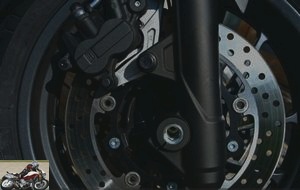
Consumption
With a 14-liter tank, the XMax 400 offers a front reserve range of around 210 kilometers, depending on driving. In town, with a very smooth ride and smooth starts, the scooter goes on reserve at 230 kilometers. On high speed motorways, the reserve can ignite from 190 km. Fortunately, there is still enough to do then a good forty kilometers (even 50 by slowing down a bit). In fact, if we drive at a stabilized speed on the national road, consumption can just drop below the bar of 5 liters per hundred (4.9 l / 100) which then gives a theoretical autonomy of 270 km. The gauge is fairly accurate, causing the first stick to disappear after 70 km, then about one stick every 30 km. It is then the last stick that starts flashing to signal the passage in reserve.
Convenient
Two front storage compartment integrated into the apron and a huge box under the saddle allow you to take everything you need with you for a weekend.
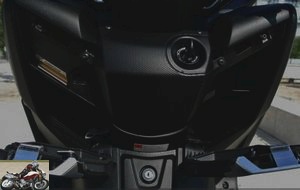
In fact, you can wedge two modular helmets under the saddle without worry (a diagram printed in the center explains in which direction to insert them) as well as two rain suits. With this space, the maxi-scooter offers one of the largest capacities on the market and this is a real plus for its daily use.
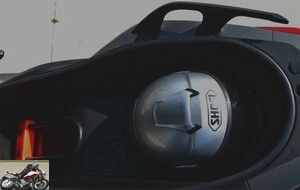
Note the internal heat under the saddle which will allow you to recover warm gloves and a dry helmet (ideal for warm business, to the detriment of any frozen food races).
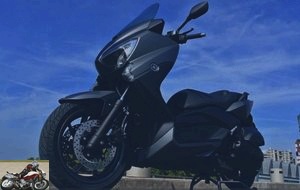
Conclusion
Valuable, dynamic, well finished, the XMax 400 is an excellent maxi-scooter that will delight those looking for a practical maxi-scooter, powerful enough to also take them on weekends, but without spending the price of a 530 or 600 cm3 (and also with less risk of theft). The biker who does only the city and the occasional peri-urban will be fully satisfied with a 250 cm3, lighter and cheaper, even if it is only 500 euros less, but above all five thousand euros less than ‘a TMax! Those who want to treat themselves to duo escapes of several hundred kilometers will rather eye the side of the 400 with its higher top speed. Last point, with a model made in France (apart from the Minarelli engine made in Italy), the XMax will also delight the most chauvinistic of bikers..
Strong points
- Braking
- Storage
- Finishing
- Protection
Weak points
- Saddle height
- Comfort
- Lack of ABS
Datasheet
Test conditions
- Itinerary: from the city for a week, various small roads, the motorway for 500 km
Minarelli
Related articles
-
2015 vintage Thirteen years since the TMax made its appearance with several major evolutions since the TMax 500 cm3. If the maxi scooter evolves again in…
-
Yamaha TMax 530 ABS scooter test
The Thug Star The TMax is the big Yamaha scoot, even THE big benchmark maxi-scooter, to such an extent that it is the main target of copies of the…
-
Single cylinder, 292 cm3, 28 hp at 7,250 rpm, 29 Nm at 5,750 rpm, 179 kilos, € 5,899 Yamaha’s mid-size scooter gets a makeover and gets traction control…
-
Yamaha XMax 250 maxi-scooter test
In the XMax family, I ask … the father! Declination of the TMax in smaller, the XMax is especially the father or the big brother of the XMax 125. Same…
-
Yamaha Fazer FZ6 motorcycle test
The GT roadster The Fazer has been completely revised for its edition 2004, Euro2 standard obliges. In fact, the new model has nothing to do with its…
-
Yamaha VMax 1700 motorcycle test
The return of a legend The return of the good, the bad and the tonic-truante. Certain celestial objects cross our orbit according to a periodicity which…
-
Yamaha XT 660 R motorcycle test
City rat who knows how to transform into a field rat From the first letters, the XT informs that its history is loaded with lasting memories. Today XT…
-
Appeared in 2006 and revamped in 2010, the XMAX 125 has remained at the top of sales since then with more than 8,000 sales in 2011. Yamaha thus seems to…
-
200 hp at 13,500 rpm, 112 N.m at 11,500 rpm, 199 kilos with full fuel, from € 18,499 Is the Crossplane engine an advantage in road use ? Even if the…
-
Fashion victim ! The single-cylinder trail is out of fashion and that’s a shame. Because the Yamaha XTZ 660 Tenere remains the embodiment of the…